HELP FROM A SPECTRUM ANALYSER
Using a Spectrum Analyser
In this article I hope to show you some of the uses and advantages of computer-based spectrum analysis to discover the modulation of an unknown intruder (I would mention the disadvantages too, but I don't know of any). These computer programs (there are several and here are brief descriptions of them) combine a mathematical technique known as the Fast Fourier Transform (FFT) with the processing power of modern personal computers to perform a kind of analysis that was totally unavailable to ordinary people only a decade ago.Just as you listened to a signal while tuning your receiver slowly through it using a narrow bandwidth in order to discover the spectral components of the signal, a spectrum analyser does this same sort of thing automatically and presents a picture of the signal spectrum, as "heard" in your receiver's audio output, so you can see right away how many channels there are, what is the frequency shift, is there any power supply "hum" on the carrier, and with a little practice you can guess at whether FSK or PSK is being used.
There are two common methods of display used by these analysers: one is an instantaneous picture of the spectrum which changes from moment to moment, in the same way as an oscilloscope displays a waveform; the other presents a history of the signal's spectrum over a short or long period of time by displaying succesive spectra in raster or "waterfall" fashion using different shades of gray or colour to show the amplitude of the signal at any one frequency and time. This second method provides a lot of information in one picture and is preferred for most purposes. All of the spectrograms shown here use the waterfall display method (the images here are also in reverse colour for easier viewing and printing).
On-Off-Keyed Carrier
Let's start with a simple case of on-off-keyed carrier. Sending continuous Morse dots or continuous dashes is a good example of a simple on-off-keyed (OOK) carrier. Some military stations use on-off-keyed carrier as a channel marker or as a synchronizing signal for their cipher equipment. In practice, the on and off periods are usually of equal duration, sometimes referred to "1:1 reversals". (A bit of useful jargon: the term "reversals" is often used to describe keying of the transmitter alternately between on and off, or between Mark and Space, or between 0 and 1.)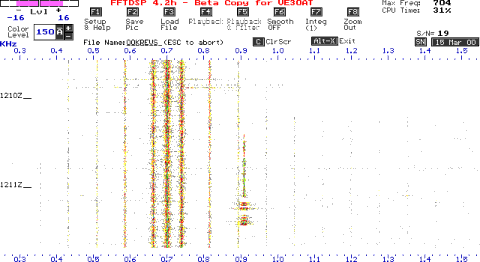 At right is the spectrogram of an OOK carrier being keyed at 38 Hz or
76 bauds. Frequency is displayed horizontally and time flows down
the screen, like a waterfall. Notice how the carrier is accompanied
by two spectral lines, one on each side, 38 Hz above and below the
carrier frequency. There are also many odd-numbered harmonics (x3,
x5, etc) of these lines on each side of the carrier which are due to the
fact that the carrier is 100% modulated and with fairly fast turn-on and
turn-off times.
At right is the spectrogram of an OOK carrier being keyed at 38 Hz or
76 bauds. Frequency is displayed horizontally and time flows down
the screen, like a waterfall. Notice how the carrier is accompanied
by two spectral lines, one on each side, 38 Hz above and below the
carrier frequency. There are also many odd-numbered harmonics (x3,
x5, etc) of these lines on each side of the carrier which are due to the
fact that the carrier is 100% modulated and with fairly fast turn-on and
turn-off times.Well, this is an almost trivial example, but two related points should be noted. If the signal were in fact sending frequency-shift-keyed reversals, that is, alternating RTTY Mark and Space elements, the spectrum would look like two OOK carriers, one on the Mark frequency and one on the Space frequency. This is because FSK reversals are the same as on-off keying of the Mark frequency and off-on keying of the Space frequency. Such signals can often be seen; in fact they are more common than the simple OOK carrier that we started out with.
The second point is that an OOK carrier can often look like a carrier that is carrying no intelligence but which is amplitude modulated by "hum" in the power supply. Such hum might be caused by poor regulation of the power supply voltages to the transmitter so that they vary at the same frequency (usually 50 or 60 Hz) as the alternating current mains supply and/or harmonics of it. Routinely looking for power supply hum on any intruding signal can provide an important clue about the location of the transmitter, as few countries use both 50 and 60 Hz mains frequency.
Two FSK Printer Signals
Amateurs in Region 3 are often bothered by an RTTY signal which occupies 14212 kHz at odd times during the day. To my knowledge, no schedule has ever been discovered for these printer broadcasts and, although the broadcasts are often as short as a minute or two, the signal is strong.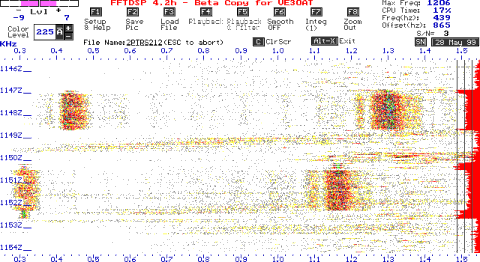 Shown at right is a spectrum analyser display showing the transmission of
two successive messages on 28 May 1999. The display spans a time of
just over eight minutes. The first message began at 1147 Z and
lasted about a minute and a half; the second began just after 1150 Z and
lasted about two minutes. At any one time during these periods, you
can see two broad vertical bands in the display representing the received
Mark and Space frequencies of the RTTY signal. These spectral components
are broadened in frequency by the keying transients of the transmitter and
the shortness of individual Mark and Space elements. Notice how the
transmitter operator tested the transmitter briefly on Mark and Space
frequencies before beginning the message, resulting in a much more narrow
spectral line for these periods when unmodulated carrier was being
sent. You can also see faint (weak) vertical bands on each side of
the Mark and Space frequency; these are keying sidebands arising from the
keying speed of the RTTY transmission. After the second message, the
transmitter rested on the Space frequency (again sending unmodulated
carrier) for about 20 seconds before going off the air. Nearly
horizontal smears across the display were the result of interfering
signals present in the bandpass of the receiver.
Shown at right is a spectrum analyser display showing the transmission of
two successive messages on 28 May 1999. The display spans a time of
just over eight minutes. The first message began at 1147 Z and
lasted about a minute and a half; the second began just after 1150 Z and
lasted about two minutes. At any one time during these periods, you
can see two broad vertical bands in the display representing the received
Mark and Space frequencies of the RTTY signal. These spectral components
are broadened in frequency by the keying transients of the transmitter and
the shortness of individual Mark and Space elements. Notice how the
transmitter operator tested the transmitter briefly on Mark and Space
frequencies before beginning the message, resulting in a much more narrow
spectral line for these periods when unmodulated carrier was being
sent. You can also see faint (weak) vertical bands on each side of
the Mark and Space frequency; these are keying sidebands arising from the
keying speed of the RTTY transmission. After the second message, the
transmitter rested on the Space frequency (again sending unmodulated
carrier) for about 20 seconds before going off the air. Nearly
horizontal smears across the display were the result of interfering
signals present in the bandpass of the receiver.Significantly, the spectrogram shows that the frequency shift used for each message was about 850-860 Hz but the center frequency of the FSK transmission was different for each message. Over a period of several months, it was found that there were two distinct frequencies being used for these broadcasts and on a few rare occasions transmissions were heard on both frequencies at the same time, proving that two separate transmitters were being used. In the spectrogram displayed here, the receiver tuning was not changed between messages so if you use the audio frequency scale at the bottom of the display, you can calculate for yourself the difference in center frequency between these two transmitters. If you find a difference of about 125 Hz, your eye is good.
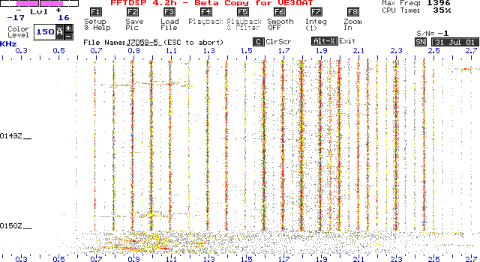 The spectrogram at right shows a jammer which to the ear sounds just like
some loud buzzing signal or indescribable noise. The base frequency
of the display was 7058.5 kHz and the signal was recorded in USB mode, so
the signal was on a center frequency of about 7060.1 kHz in our 40 m
band. The jammer left this frequency at about 0150 UT. Using
the frequency scale at the bottom of the display, you can see the many
spectral components at intervals of 100 Hz with a smaller number at
intervals of 50 Hz, and it is easy to see that the signal occupies a
bandwidth of almost 2 kHz.
The spectrogram at right shows a jammer which to the ear sounds just like
some loud buzzing signal or indescribable noise. The base frequency
of the display was 7058.5 kHz and the signal was recorded in USB mode, so
the signal was on a center frequency of about 7060.1 kHz in our 40 m
band. The jammer left this frequency at about 0150 UT. Using
the frequency scale at the bottom of the display, you can see the many
spectral components at intervals of 100 Hz with a smaller number at
intervals of 50 Hz, and it is easy to see that the signal occupies a
bandwidth of almost 2 kHz.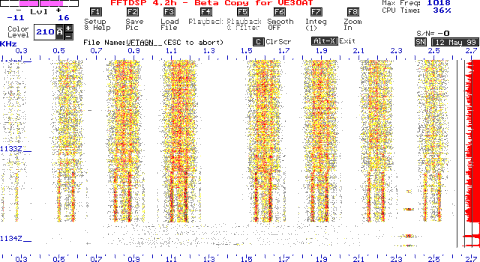 For comparison, the spectrogram at right shows a Russian (or Chinese?) VFT
signal on 14154.3 kHz center frequency, recorded in May 1999. As the
recording begins, the signal is sending traffic and you can see each of
the 8 data channels, separated by 300 Hz (except 450 Hz between the two
center channels). These 8 channels just fit into the 2.4 kHz
bandwidth of the receiver and the maximum frequency span of the spectrum
analyser. Soon after 1133 Z the traffic ended and the signal
changed to an "idle" condition in which you can see two synchronizing
lines separated by about 70 Hz in each channel. In this condition
the signal will make a strong buzzing noise in your receiver. Then,
just before 1134 Z the signal went off the air. It is not uncommon for
these VFT signals to remain in an idle condition for long periods of time,
during which it is easy to mistake them for a broadcast jammer, unless of
course you use a spectrum analyser to show the true nature of the
signal.
For comparison, the spectrogram at right shows a Russian (or Chinese?) VFT
signal on 14154.3 kHz center frequency, recorded in May 1999. As the
recording begins, the signal is sending traffic and you can see each of
the 8 data channels, separated by 300 Hz (except 450 Hz between the two
center channels). These 8 channels just fit into the 2.4 kHz
bandwidth of the receiver and the maximum frequency span of the spectrum
analyser. Soon after 1133 Z the traffic ended and the signal
changed to an "idle" condition in which you can see two synchronizing
lines separated by about 70 Hz in each channel. In this condition
the signal will make a strong buzzing noise in your receiver. Then,
just before 1134 Z the signal went off the air. It is not uncommon for
these VFT signals to remain in an idle condition for long periods of time,
during which it is easy to mistake them for a broadcast jammer, unless of
course you use a spectrum analyser to show the true nature of the
signal.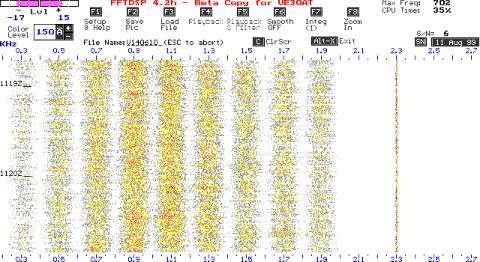 There
is another VFT data signal which is often heard coming from Russia or
China. It is a 12-channel signal with 200 Hz spacing between
channels and a pilot carrier 400 Hz above the highest frequency data
channel. The spectrogram at right shows the highest 9 channels of
the total 12, and the pilot carrier above them. The signal is
believed to be PSK and, because traffic is being sent throughout the
recording shown here (no idle periods), only a band of noise is observed
in each data channel. In practice it is usual for the pilot carrier
of these signals to be on a radio frequency ending in "x.3 kHz". It
is believed that the pilot carrier might be a tuning aid and does not
necessarily mean that single-sideband is being used.
There
is another VFT data signal which is often heard coming from Russia or
China. It is a 12-channel signal with 200 Hz spacing between
channels and a pilot carrier 400 Hz above the highest frequency data
channel. The spectrogram at right shows the highest 9 channels of
the total 12, and the pilot carrier above them. The signal is
believed to be PSK and, because traffic is being sent throughout the
recording shown here (no idle periods), only a band of noise is observed
in each data channel. In practice it is usual for the pilot carrier
of these signals to be on a radio frequency ending in "x.3 kHz". It
is believed that the pilot carrier might be a tuning aid and does not
necessarily mean that single-sideband is being used.